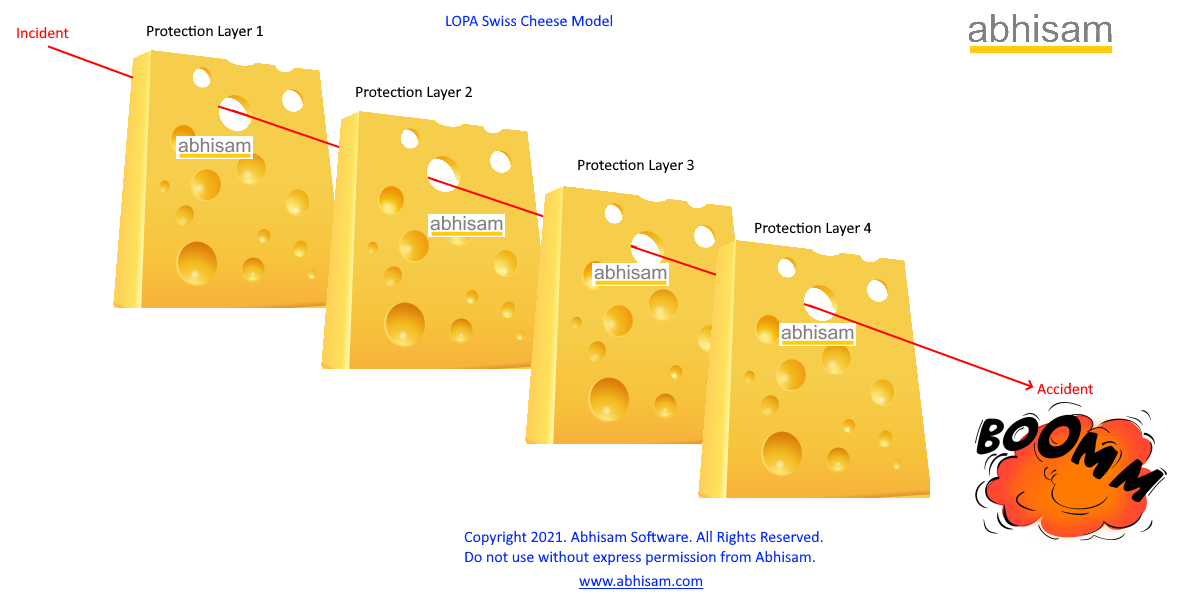What is LOPA?
LOPA is short for Layer of Protection Analysis. It is also referred to sometimes as Layers of Protection Analysis. It is considered a semi-quantitative risk assessment technique.
Abhisam’s Layer of Protection Analysis training course is an easy way to learn it.
What are protection layers?
An easy way to understand protection layers is to study an example of a residential house, located in a not so safe neighborhood. The residents of the house are aware that they need to have some kind of security measures in place in order to protect them from random vandals, thieves, burglars and so on.
So they install various things like a barbed wire fence with a locked gate, CCTV cameras near the door, a ferocious guard dog who prowls the front porch and strong locks on all doors and windows that are also fitted with burglar alarms.
These are protection layers. Any intruder would have to defeat at least three of them, sequentially (jump the fence, tackle the dog and break the lock) before gaining entry into the house.
This same concept in used in industry to protect industrial processes from accidental explosions, fires, toxic releases and other unwanted incidents. So for example, a gasoline storage tank in a tank farm would have a level indicator with an alarm, that alerts the operator to stop filling it when it reaches a high level and in case the operator fails to do that, an overfill prevention system that consists of a level switch, a safety logic solver and automated on/off valves will shut the inlet lines to the tank. In this case there are two layers of protection on the tank. The tank will overflow only if both fail.
What is the Swiss Cheese LOPA Model?
The LOPA concept is explained easily with the Swiss cheese LOPA model. If you have seen Swiss cheese, you know that it has holes, like you can see in the picture below.
.
Think of the Protection Layers as different slices of cheese (with holes).
If somebody lines them up and shoots an arrow (William Tell?) near the first layer, then only if all the holes are aligned will the arrow be able to pass through. This is known as the Swiss cheese LOPA model or the Swiss Cheese Risk Assessment model. 
If we imagine that an incident in the facility (say high level of a flammable liquid in a storage tank) occurs, then an accident will take place only if all the protection layers fail. In the above picture think of the Incident as where the arrow comes from. It will result in an accident only if all the holes in the layers are lined up in a row.
The incident arrow then passes through all layers unhindered and results in an accident, such as an explosion due to the overflow of the flammable liquid and presence of an ignition source.
To have a reasonably good degree of protection, one must have multiple layers of protection. If we have just one layer or two and they both fail, then we have an accident!
For example, in the Buncefield accident in UK, the overfill level switch was non functional (failed layer) and the control room operator was also distracted (failure of second layer of protection), resulting in an accident that cost millions of pounds in lost assets, claims and fines. Luckily there were no fatal injuries because the accident occurred on a weekend when most of the neighboring facilities have very less people around. This is an example of failure of multiple layers of protection.
Is LOPA that simple to understand and implement?
No, the concept is easy to understand, but in order to carry out a risk assessment using it, one must also know and consider the failure rates of the various protection layers, the probability of failure of the protection layers, the possible consequences if they fail and the amount of risk reduction that is needed in order to have a tolerable risk level of the installation.
This is difficult if you do not have formal training. But relax, we have the solution for you. Read on below.
Where can I learn LOPA?
You can easily learn it when you take the Abhisam Layer of Protection Analysis training course here. (Click the image to see).
It is a completely self-paced course and teaches via real life examples, using animations and simulations, in a step by step manner in a realistic setting, using LOPA Worksheets.
LOPA Certification
When you complete the course, you can conduct your own LOPA Study for your facility or your client’s facility. Further, if you take the associated exam, you can also earn a Certificate of Competency in LOPA, alongwith an electronic badge that you can add to your Linkedin profile or display online on other places. This gives you higher visibility.


